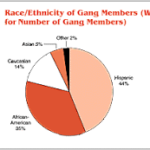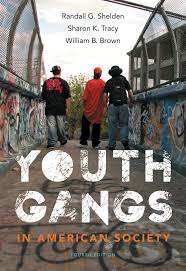Youth gangs in the United States represent a complex social phenomenon with significant implications for communities, law enforcement, and public policy. This essay will explore the origins and characteristics of youth gangs, the factors contributing to their formation, the impact on society, and strategies for prevention and intervention.
Origins and Characteristics of Youth Gangs
Youth gangs are typically defined as organized groups of young people who engage in criminal activities and exhibit a shared identity and sense of belonging. While gangs have existed in various forms throughout history, contemporary youth gangs in the USA emerged in urban centers during the mid-20th century and have since evolved in structure, composition, and activities. Gangs may vary in size, structure, and level of organization, with some operating as hierarchical criminal enterprises and others as loose affiliations based on social ties and neighborhood networks.
Factors Contributing to Gang Formation
Numerous factors contribute to the formation and proliferation of youth gangs, including socioeconomic disadvantage, family dysfunction, community disorganization, and exposure to violence and trauma. Economic marginalization, lack of educational and employment opportunities, and social exclusion can push young people into gang involvement as a means of survival or social advancement. Additionally, familial instability, neglect, and abuse may push youth towards gangs as alternative sources of support and belonging. Peer pressure, cultural influences, and the glamorization of gang culture in media and popular culture further contribute to gang recruitment and retention.
Impact on Society
The presence of youth gangs has profound social, economic, and public health implications for communities and society at large. Gang-related violence, including shootings, stabbings, and assaults, poses significant threats to public safety and community well-being, leading to fear, trauma, and social disruption. Gang activities such as drug trafficking, extortion, and property crimes contribute to the perpetuation of poverty, blight, and social decay in affected neighborhoods. Moreover, the cycle of gang involvement perpetuates intergenerational poverty and crime, as children born into gang-affiliated families are at increased risk of gang recruitment and involvement.

Strategies for Prevention and Intervention
Addressing youth gang involvement requires a multifaceted approach that combines prevention, intervention, and suppression strategies. Prevention efforts aim to address underlying risk factors and build protective factors to reduce the likelihood of gang involvement. This includes early childhood interventions, family support services, positive youth development programs, and community-based initiatives that promote education, employment, and civic engagement. Intervention strategies target at-risk youth already involved in gangs or displaying risk factors for gang involvement, offering targeted interventions such as mentoring, counseling, vocational training, and alternatives to incarceration. Suppression strategies focus on law enforcement efforts to disrupt gang activities, dismantle criminal networks, and hold gang members accountable for their actions through targeted policing, gang injunctions, and prosecution under anti-gang statutes.
Gang Dynamics and Subculture
Youth gangs often develop distinct dynamics and subcultures that shape their identity, behavior, and interactions within their communities. These dynamics may include hierarchies based on age, status, or criminal involvement, as well as rituals, symbols, and codes of conduct that reinforce group cohesion and loyalty. Understanding the internal dynamics of gangs can provide insights into their motivations, decision-making processes, and resilience to intervention efforts.
Gender and Diversity in Gangs
While gangs are often portrayed as male-dominated, there is growing recognition of the diversity of gang membership, including the involvement of girls and young women. Gender dynamics within gangs may differ from those in mainstream society, with female gang members facing unique challenges and roles, such as serving as caregivers, facilitators, or enforcers within the gang hierarchy. Additionally, gangs may reflect the racial, ethnic, and cultural diversity of their communities, with different groups exhibiting distinct norms, affiliations, and rivalries.
Gang Prevention Through Education and Outreach
Education and outreach efforts play a vital role in preventing youth gang involvement by providing young people with alternatives to gang affiliation and empowering them to make positive choices. School-based prevention programs, community outreach initiatives, and youth engagement activities can promote pro-social attitudes and behaviors, build resilience to gang recruitment tactics, and provide opportunities for personal and academic development. By fostering positive relationships with trusted adults, peers, and community leaders, young people can develop the skills and support networks needed to resist gang involvement.
Trauma-Informed Approaches to Intervention
Many youth gang members have experienced trauma, adversity, and adverse childhood experiences that contribute to their involvement in gangs. Trauma-informed intervention approaches recognize the impact of trauma on young people’s behavior and well-being and seek to provide compassionate, culturally responsive support that addresses their underlying needs. This may involve trauma-informed counseling, mental health services, and peer support groups that help youth heal from past trauma, develop coping skills, and build resilience to future challenges.

Reentry and Rehabilitation for Former Gang Members
For youth who have been involved in gangs, successful reentry into society requires access to comprehensive reintegration and rehabilitation services. This includes support for education, vocational training, employment, housing, and healthcare, as well as mentoring, peer support, and positive social connections that help former gang members transition to a law-abiding lifestyle. Reentry programs that address the root causes of gang involvement, such as poverty, substance abuse, and lack of social support, can reduce recidivism and promote long-term success and stability.
Community Empowerment and Collective Action
Addressing youth gang involvement requires collective action and collaboration among stakeholders at the community, city, and national levels. Community empowerment strategies, such as community policing, neighborhood revitalization, and grassroots organizing, empower residents to take ownership of their neighborhoods and work together to address underlying social determinants of crime and gang involvement. By fostering partnerships between law enforcement, schools, faith-based organizations, businesses, and residents, communities can develop holistic solutions that promote safety, opportunity, and inclusion for all young people.
Restorative Justice and Healing
Restorative justice approaches offer alternative pathways for addressing youth gang involvement by prioritizing healing, reconciliation, and community restoration over punitive measures. Restorative justice processes bring together affected parties, including victims, offenders, and community members, to engage in dialogue, repair harm, and work towards mutual understanding and resolution. These approaches empower young people to take accountability for their actions, make amends, and reintegrate into their communities in a positive and constructive manner. By fostering empathy, empathy, and accountability, restorative justice practices can break the cycle of violence and promote healing and transformation for individuals and communities affected by gang-related crime and conflict.
Long-Term Prevention and Resilience-Building
Ultimately, addressing youth gang involvement requires a long-term, holistic approach that focuses on prevention, intervention, and community resilience-building. This includes investing in early childhood development, family support services, youth mentoring programs, economic opportunities, and community-based initiatives that promote positive youth development and address the root causes of gang involvement. By building strong, resilient communities where all young people have opportunities to thrive, we can create a future where youth gangs are no longer a pervasive threat and all individuals have the chance to reach their full potential.

Conclusion
Youth gangs in the USA represent a complex social problem with deep-rooted causes and far-reaching consequences. Addressing gang involvement requires a comprehensive, multi-sectoral approach that addresses the underlying social, economic, and systemic factors driving gang formation and perpetuation. By investing in prevention, intervention, and suppression strategies that empower communities, support families, and provide opportunities for youth, stakeholders can work towards building safer, healthier, and more resilient communities for all.



